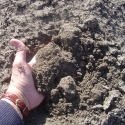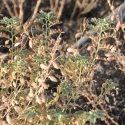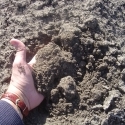12 Jul 2012
Is there a need for more Calcium
By Dr Rob Mikkelsen (California, USA) and Dr Rob Norton (Australia)
Humans and animals need Ca to build strong bones. Plants also require plenty of Ca to develop strong cell walls and membranes. Animals fed a diet with low Ca develop weak bones and osteoporosis. Similarly, insufficient Ca in plants leads to a breakdown of cell walls and membranes, and to a variety of disease and post-harvest problems. In addition to plant nutrition benefits, sufficient Ca has a role in maintaining soil physical properties, alleviating subsoil acidity, and the reclamation of sodic soils.
There are soil conditions where Ca applications are very helpful. Sandy soils and crops irrigated with low Ca water may be particularly vulnerable to low Ca availability. Soils with low pH generally have low Ca availability. Unusually high exchangeable Mg may pose a problem for Ca uptake by roots.
Most agricultural soils contain considerable amounts of Ca. A good estimate is that each cmol of exchangeable Ca is equivalent to 400 kg/ha to a depth of 15 cm. Many soils contain several tons of exchangeable Ca on cation exchange sites. Therefore, it may take large applications of Ca to make significant changes in soil chemistry.
Soil pH generally provides a good assessment of Ca levels in soils. Alkaline soils contain more calcium than acid soils, and even in soils where Ca is present as gypsum (Calcium sulfate) or limestone (Caclium carbonate), some of the Ca from these compounds will be available to the crop. This is because these minerals are in a solubility equilibrium reaction. For example, gypsum has a solubility of around 2.4 g/l and calcium carbonate has a solubility of 0.013 g/l so the amount of Ca that results from the gypsum is significantly more that the amount from the calcium carbonate. The sulfate form releases more free calcium (Ca2+) ions than the carbonate form because the Ks (solubility product) of calcium sulfate is around 10,000 times more than that for calcium carbonate (3.14x10-5 versus 4.8x10-9).
Probably the best known symptom of Ca deficiency is blossom-end rot of tomato fruit, but this problem is closely related to plant water stress and the difficulty in delivering Ca to the fruit. This illustrates one of the problems with Ca deficiencies—is it a lack of Ca that is the problem or is it a problem with delivery of Ca within the plant?
In soil that seems to have adequate Ca, why do deficiency symptoms sometime occur? The problems often appear when Ca does not adequately move to the plant organs where it is needed. Calcium moves primarily in the transpiration stream of water moving up from the roots. Once in the plant, Ca is not readily mobile from one plant part to another. Plant organs that have low transpiration (e.g. fruits such as melons, apples, and tomatoes with a waxy skin, or the inner/sheltered parts of leafy plants such as lettuce) can develop low-Ca disorders. When these disorders develop, sometimes it is related to the soil Ca supply, but it is frequently related to water stress, cool temperature, and limited transpiration.
When low Ca is causing plant problems, start with getting the soil tested. Make sure there is adequate Ca present and low pH is not a problem. Large additions of Ca inputs such as lime or gypsum may be recommended to address these conditions. When targeted inputs are needed during the growing season, several highly soluble Ca sources are available. They may be best applied to the active root zone to promote rapid uptake. Foliar sprays containing Ca can also be beneficial to address potential deficiencies, but only a limited amount of Ca can be assimilated this way.
Ask for the evidence. While low Ca status can appear, it is not always an indication that yields will increase if additional Ca is supplied but for many crops (especially horticultural crops) getting Ca supply right is more about quality than yield. Ask your supplier for results from replicated, randomized and statistically analysed experiments on these products before making a judgment about using them.
Calcium is required by plants in relatively large amounts. Many forage crops, such as lucerne, remove over 100 kg Ca/ha/yr in harvested hay. When plant deficiencies occur, it is necessary to examine the cause of the problem in order to know the best response. There are many excellent sources of Ca available, but their appropriate use depends on your individual situation.




